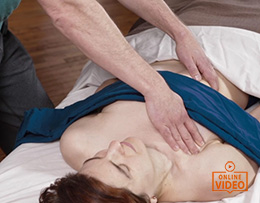Leading medical experts agree that breath awareness and conscious breathing can be successfully applied in the prevention, intervention, treatment and recovery of numerous health conditions. Massage therapists who incorporate elements of conscious breathing into their sessions will promote their clients’ ability to experience more dramatic, healthful results than those who receive massage alone.
A human can survive several weeks without food, several days without water, but only a few minutes without air. Every cell in the body requires a continual exchange of oxygen and carbon dioxide to function properly. Breathing is this mechanism of exchange, feeding and cleansing the body’s cells with a continuous cycle of intake and exhaust. Breathing function can be impeded by restrictions in the air passages due to illness, injury, chronic weaknesses or blockage by foreign objects such as dust or mucus. Tense muscles, poor posture, tight clothing or emotional stress can also restrict breathing.
The two classifications of respiration are chest breathing and abdominal breathing. The distinction is in what muscles are used for breath inhalation and exhalation:
- Chest breathing is when we solicit the upper chest muscles to open up the rib cage. This results in shallow breathing, where too little air is drawn into the lungs. Consistent chest breathing results in poorly oxygenated blood, prompting the heart to pump harder to feed the body’s cells with oxygen. Upper chest breathing fills only about one quarter of the lung’s capacity. Emotional stress is a common cause of rapid, shallow chest breathing and can be addressed by integrated bodywork techniques.
- Abdominal breathing does not indicate filling the abdomen with air, but rather using the muscles in the abdomen, sides and back of the lower torso to permit the maximum lowering of the diaphragm, fully expanding the chest. When the lungs can be filled, up to eight times more air is recruited per breath than chest breathing. This increased air volume allows for greater blood oxygenation without stressing the cardiopulmonary system.
When we breathe fully and deeply, the belly, lower ribcage, and lower back all expand on inhalation, drawing the diaphragm down deep into the abdomen, and retracting upon exhalation. The vertical movement of the diaphragm combined with the horizontal movement of the belly, ribcage, and lower back during abdominal breathing helps detoxify the inner organs, promote blood flow and peristalsis, and pump lymph more efficiently through the lymphatic system. Each of these benefits mirror the goals of massage therapy. The combination of the two is an ideal union for enhancing health. Efficient abdominal breathing is supported by the following factors:
- Proper posture – Good posture allows the chest muscles to expand with minimal effort. Slouching forces the weight of the upper chest onto the abdomen. Poor posture demands more energy for respiration than when the back is straight and relaxed.
- Refraining from overeating – Overeating can extend the stomach to press on the diaphragm, hindering its movement. This restriction limits abdominal breathing.
- Relaxation – When we are tense, our muscles naturally contract. In addition to feeding the pain cycle, muscle tension inhibits abdominal breathing. Focusing on muscular relaxation allows for greater chest expansion while conscious abdominal breathing also helps relax muscles.
The use of breathing to relax muscles is a major component of many techniques for stress reduction and relaxation. All of the major exercise/relaxation techniques, such as yoga, qi gong, tai chi and meditation, utilize the benefits of abdominal breathing.
Helping a client learn abdominal breathing will directly benefit muscles that have been working too hard to lift the ribs. However, when instructing a client, make certain that your directions are not misinterpreted. Some new students of abdominal breathing overemphasize the new pattern, losing the ability of the chest to expand. Not only should the belly expand on the in-breath, but the breath should then continue up past the costal arch, expanding the ribs as well. Since many deep breathing techniques exist, look for one that is most congruent with your style. Here is one exercise to get clients breathing the right way:
- Have your client lie on their back comfortably.
- Place their hand on their stomach, just below the belly button.
- They should take a deep breath in through their nose, and then hold it for a moment.
- Then, they should slowly exhale through their nose.
- When the client thinks all of the air is expelled, instruct them to open their mouth to let the rest out.
For more abdominal breathing suggestions, reference the article Diaphragm Strengthening for Neck and Shoulder Pain from well-known therapist, Doug Alexander.
Massage focusing on the chest area and abdominal muscles can relax the muscles used for conscious respiration, paving the way for clients having difficulty with breathing exercises. Practitioners must be patient and communicative with their client as changes to breathing patterns are attempted.
With conscious effort, breathing is a task anyone can control. By instructing your clients on the benefits and techniques of abdominal breathing, you are giving them a self-empowering tool to change their life. Through the increased amount of oxygen supplied by abdominal breathing, massage therapists can amplify the benefits of their work.
Recommended Study:












